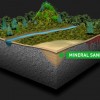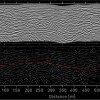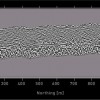The calculation of resource volumes for large mineral sands deposits is the process of systematically compiling all known data in order to define the volume of ore contained and its intrinsic economic value. Traditionally, this process has been highly speculative in nature, as the layer thickness between even closely-spaced boreholes can be highly variable. The issue of horizon continuity is of critical importance in mine modeling and resource definition. Accurate volume estimates are difficult to derive from drilling data alone, as the spacing of an economically-viable drilling program is often greater than the spatial frequency of the variations in profile thickness. The limitations associated with this inferential approach to resource estimation can be mitigated through the use of UltraGPR, thereby maximizing mining optimization by reducing contamination and ore body loss.
Resource evaluations of heavy mineral deposits include parameters that consider the thickness, grade and chemistry variations in the sand body. In tabular deposits such as heavy minerals, reliable resource estimation depends on reliable thickness estimates. This is particularly the case when the thickness of the deposit is more spatially variable than the grade. The ability of UltraGPR to rapidly determine both the base of the profile and well as interstitial depositional morphology is of significant value to exploration and resource geologists as it addresses issues related to complex geological conditions as well as variations in profile thickness. In particular, the latter restricts even tightly-spaced infill drilling campaigns from converging on a stable volume estimate. UltraGPR has been applied to mineral sands exploration to depths exceeding 120 m.



